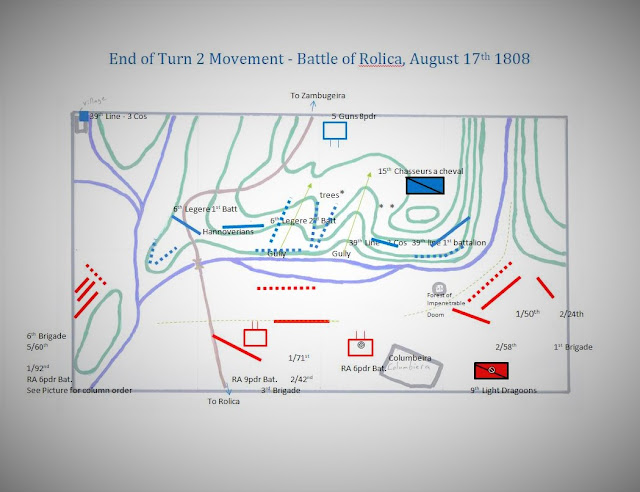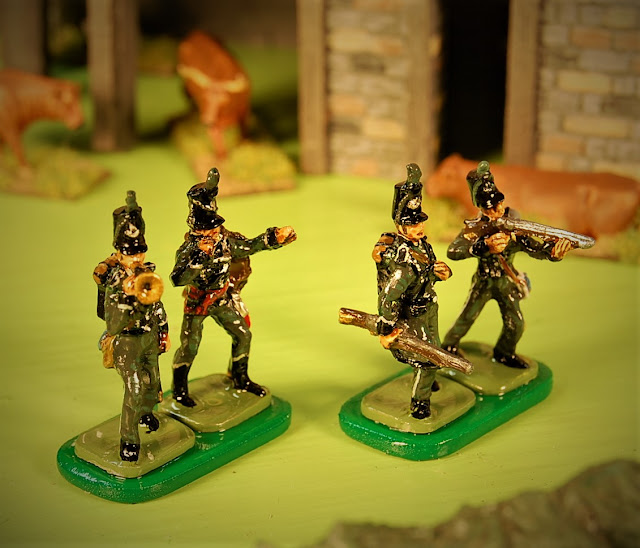The battle begins on the slopes of the hills to the South of Rolica, just by the small Portuguese village of Columbeira. The small French force of five battalions has occupied a line of hills covering about a mile, in the hope of delaying or stopping the British advance on the French main force, still gathering miles to the rear. Lord Wellesley, the future Duke of Wellington, is fresh off the boat and leading his small allied army into Portugal to chase out the hated French.
https://www.britishbattles.com/peninsular-war/battle-of-rolica/
Turn 1
 |
The left flank of the French army has taken position in low lying trees and scrub along the cliff like slopes above a small stream bed
|
 |
The British view of the battlefield from the center of their position.
|
 |
Turn 1 sees some initial jockeying of position as the British brigade on their right flank prepares for an assault.
|
 |
In the center the British battalions spread out and deploy their artillery to take advantage of their 3 to 1 advantage in heavy ordinance.
|
 |
A bird's eye view of the British center
|
 |
As turn 2 begins more British forces will come on to the field to put pressure on every point of the French defensive line!
|
 |
A battalion of French Legere rushes to meet the threat on their right!
|
 |
The French left will be a tough nut to crack!
|
TURN 2
 |
On the British Right the combined light companies of three full line battalions attempt to soften up the French line, but the voltigeurs, crouching behind granite boulders and low scrub, send back a hail of lead inflicting significant casualties on the advancing light companies.
|
 |
In the centre, the gallant French have unwisely advanced beyond the shelter of the woods in order to engage the advancing British light companies. Evenly matched the British and French open a galling fire on each other, but the French, having to source their powder from inferior Spanish mines, have trouble and their guns sputter. The pride of the French army in Spain, the elite voltigeurs of the 6e Legere, are shot to pieces losing a third of their strength. It is conceivable that I uttered a few choice words as I rolled to inflict casualties on the British and missed in every instance!
|
 |
On the British left the tragedy for the French continues. The British rifles from the 5/60th have combined with the light company of the Gordons to root the French out of the wooded salient they have occupied. The extra range of the rifles let's them pour fire on the French in relative safety while the French voltigeurs are decimated, losing a third of their strength in the initial exchange! A few more choice words were uttered as I rolled to save the French from the damnable British rifles - so many ones and twos have rarely been rolled all at once!
|
Suddenly the ground shook - "Well that starts the ball!", the future Iron Duke exclaims to his staff.
 |
KaBoooom! British 9 pounders thunderously open up on a half battalion of the French 39e Ligne sheltering in the woods. The concussion is so great it finally shakes the recorders of time machine reporting on these events back into colour!
|
 |
Despite the protection of the rocks and woods, the British artillery is well sighted and the first casualties against a main line Battalion are sustained. The French chef de Battalion looks on nonchalantly, confident in his men's ability to stand the fire and repel the oncoming British
|
 |
Sir Arthur Wellesley is joined by his aide and the Brigade Commander General Howard, as well as the battalion commander of the 5/60th Lt. Colonel Williams, who has galloped to the centre to report on the advancing left flank and the disposition of the French in that sector of the field.
|
This has been an enjoyable battle and so far managing the turns via email and an interactive map has worked well, an example of which is below:

























































